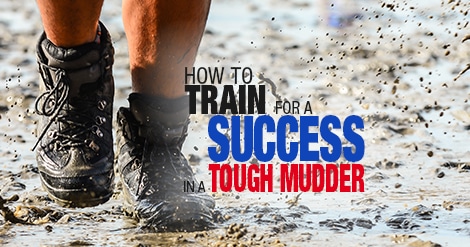On Friday, we looked at some of the risks of doing a Tough Mudder, Spartan Run, or other obstacle race. Though the absolute risk of injury during an obstacle race is very low, they are nevertheless riskier than a traditional road race.
But perhaps you, like 1.5 million other participants every year,1 laugh in the face of broken bones, electrical burns, or dislocated shoulders. How should you actually prepare for an obstacle race?
Most obstacle races are not real competitions, per se, with awards and timing chips, but as the old saying goes, if something is worth doing, it’s worth doing well.
Who wants to be slogging through the mud in the back of the pack, anyway? And given that only 78% of entrants in a Tough Mudder race are able to complete it, you definitely don’t want to be in the other 22%.
Since races like the Tough Mudder can be up to twelve miles long, your regular running training should prove very useful. But the twenty or thirty obstacles you’ll encounter along the way might be another story if you aren’t prepared—runners are not exactly known for their upper-body strength or all-around athleticism!
All this should be evidence enough that you’re going to have to prepare for an obstacle race if you want to do well in one.

Traits of a Good Tough Mudder
In a 2012 article in the Journal of Exercise Physiology, Nicole Mullins of Youngstown State University analyzed research on performance in military obstacle courses to determine what makes a good obstacle course runner.2
As you might guess, being aerobically fit, able to tolerate bursts of high-intensity effort, and having good coordination are all associated with strong performance over obstacle courses in military recruits.
Having a low body fat percentage was also identified as a strong benefit in numerous studies—good news for runners.
But another important factor is what Mullins calls your strength-to-weight ratio.
According to her research, raw strength is not as beneficial as being strong for your weight, since almost every single obstacle you’ll encounter in an obstacle race involves climbing, crawling, jumping, or some other body-weight resistance movement.
Training for a Tough Mudder
Improving this ability is also easier to improve than raw strength, and it doesn’t take any fancy weight machines: exercises like pushups, pull-ups, and bench dips are all great for improving your strength-to-weight ratio.
Mullins suggests implementing interval-style workouts that involve a mixture of moderate to fast running and body-weight obstacle-style exercises done on whatever equipment (if any) is convenient.
Some examples include “rope climbs” up a swing set, vaulting over park benches, sprinting uphill, elevated pushups, and hurdling small objects like rocks or cones.
Each of these should be separated by a segment of running—exactly how much depends on the design of the obstacle race you’ve signed up for, but anywhere from a hundred yards to half a mile is about right in most cases.
Like specific interval training for a traditional race, you probably don’t need to be doing this type of workout more than once every week for 4-6 weeks leading up to the race. You can add in some more strength exercises on the side, but otherwise you can continue with your usual run training.
Conclusion
If you want to do well in an obstacle race, or if you want to have a better chance of actually finishing one, it’s worth your time to prepare.
Add in an obstacle-style interval workout once a week and supplement that with some body-weight strength exercises to improve your strength-to-weight ratio.
With this approach, you’ll be sure to have a better time than jumping into a mud run unprepared!
Are you ready to try a tough mudder yet? What advice would you give?







2 Responses
Good article, thanks for sharing. I’d suggest when performing gym training sessions, do the exercises barefoot (or in barefoot shoes) and add some lower-body balance / stability exercises to your workout (lateral movements using Bosu barefoot is great). The uneven terrain and challenging obstacles found in tough mudders can be incredibly tough on the feet and ankles, especially for runners who typically work through a very limited range of motion.
Thanks for sharing Matt, those are great suggestions! Our readers will be especially thankful for these extra additions to the post!